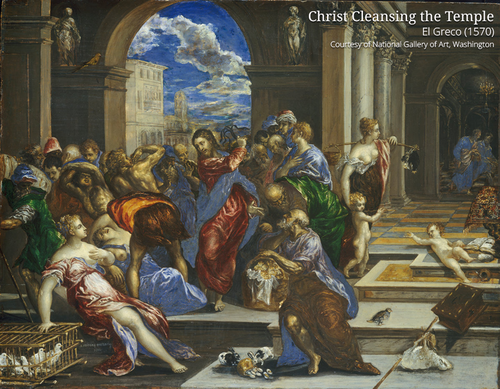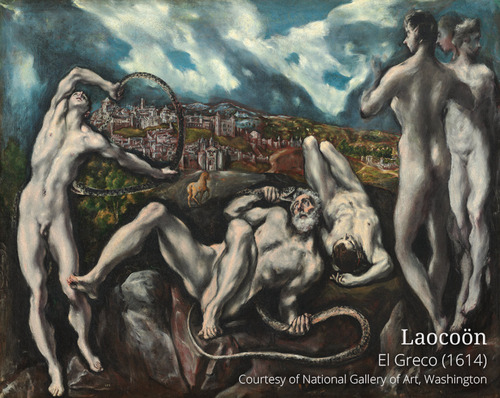El Greco: 400 Years On

Today, April the 7th, marks the 400th anniversary of the death of one of Europe’s most famous painters: El Greco.
Born on the island of Crete around 1541, El Greco came to be one of the most famous exponents of the Spanish Renaissance. After training with the Cretan school, El Greco established himself as a master painter in the early 1560s.
Between 1567 and 1570, El Greco worked in Venice. One work from this earlier period of activity, Christ Cleansing the Temple (ā.1570), is included in the USEUM collection. Like many of El Greco’s Venetian works, Christ Cleansing the Temple is stylistically highly reminiscent of artworks by the Venetian masters, particularly Tintoretto and Titian, with whom he may have worked. There is a comparable sense of drama and movement in the artwork; Christ angrily expels the moneylenders from the temple, and they twist and turn to escape him. The painting’s architecture, complicated perspective, and bold colours are also highly reminiscent of the Venetian school.
After his time in Venice, El Greco moved on to Rome. There he was accepted into the artistic and intellectual circle created by Cardinal Alessandro Farnese. The artist met numerous members of the cultural elite, including the scholar Fulvio Orsini and the artist Giulio Clovio.
El Greco moved to Spain in 1577: first to Madrid and then to Toledo, where he remained for most of his later years. Through his Roman contacts (Clovio and Orsini), El Greco came into contact with several members of Toledo’s religious community, who in turn helped the artist to secure his biggest commissions in the town.

After completing two poorly-received works for the Spanish King, Philip II, El Greco was charged with completing paintings for various religious institutions.Saint Martin and the Beggar (1597-1599) and the Madonna and Child with Saint Martina and Saint Agnes (1597-1599) were both hung above the central altar of the Chapel of Saint Joseph. These works demonstrate well the development of El Greco’s style; they indicate a continued Venetian influence as well as a Counter-Reformation tendency for directness and simplicity.
The same traits are visible in El Greco’s later works, for example, in The Holy Family with Saint Anne and the Infant John (1595-1600), an unfinished painting found in the artist’s studio at the time of his death. Saint Jerome (1610-1614) and Saint Ildefonso (1603-1614) are two further examples of works influenced by Counter-Reforming ideology; the first highlights the importance of penance, a sacrament rejected by Protestant reformers, while the second reinforces the authority of Ildefonso, the patron saint of Toledo.

By contrast, Laocoön (1610-1614) depicts not a religious but a mythological subject, the only classical theme painted by El Greco. The artist’s motives in painting the theme are uncertain; some suggest there are links between the Laocoön story and the Inquisition which was ongoing in Toledo in the early 1600s. In any case, Laocoön is an astonishing work, and arguably one of El Greco’s most striking.

El Greco fell ill while executing another commission, this time for Toledo’s Hospital Tavera. He died on 7 April 1614. With a legacy of several hundred artworks, El Greco is now widely recognised as being highly influential, particularly to later Post-Impressionist, Expressionist, Symbolist and Cubist artists. For this he is an artist worth remembering.
Emily Wilkinson is an Art Historian with an MA (Hons) in History of Art and an MSc in Renaissance & Early Modern Studies from the University of Edinburgh, having worked for numerous cultural heritage institutions in UK and the US. Emily is a Conservator and contributing author for USEUM.
